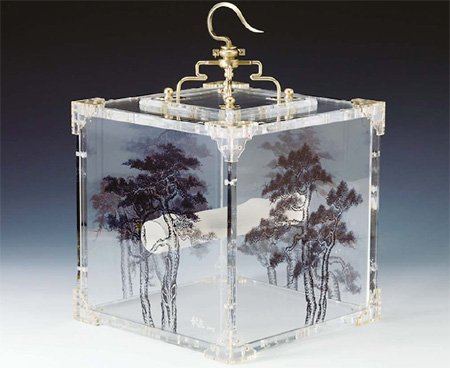Hong Kong ink art breaks boundaries
 |
| A piece by Gan Zhiqiang shows the new direction of traditional ink art. |
If you think this style of art is staid and conservative - think again.
Ink art doesn't always mean grayish paintings of mountains, rivers and forests. It can also be cool sculptures of shining metal, installations with bright neon and multimedia artwork. That's the theme of Ink Art Vs. Ink Art, a new exhibition at Shanghai Art Museum.
As a fundamental part of traditional Chinese culture, ink art has been around for more than 1,000 years in China and other Asian countries. Western culture began influencing artists, modernizing ideas about ink art in the early 1900s. Hong Kong was the most influenced by the West, which brought many possibilities for its art scene.
The exhibition, featuring 46 pieces of contemporary artworks from Hong Kong, presents the richness, diversity and solidity of the city's ink art development, said Zhang Qing, vice director of the Shanghai Art Museum.
The first important wave of ink art modernization began in Hong Kong in the 1950s and 60s and was led by Liu Guosong. One of Liu's paintings, depicting his vision of the cosmos, is included in the exhibit.
"Hong Kong is located at the southern gateway to the country and this brought special opportunities of Western influence," said Tang Hoi-Chiu, chief curator with the Hong Kong Museum of Art.
By the 1980 and 90s, Hong Kong ink art found its development direction. Artists expressed their ideas and feelings about modern life in Hong Kong through ink art and, entering the 21st century, a younger generation of artists joined the international contemporary art scene.
These artists exude the ink art spirit through various media, such as the cast steel sculpture Another Mountain by Mo Yixin and The Diary of Clouds by Wu Guanlin.
The Diary of Clouds is a set of two installations made of acrylic and wood. The artist made small patches of white erosions on transparent acrylic boards and lined the boards together to create a three-dimensional image of clouds.
"These Hong Kong artists use the essence of ink art seamlessly in their new media experimentation - no more loud cries for modernization. Ink art has stepped into the new age in the most natural fashion," said the Shanghai Art Museum's Zhang.
The art scene in Chinese mainland experienced a heat wave of ink art experimentation in the 1990s, but the heat gradually died out. "However, Hong Kong artists went on with the exploration of new ink art to create beautiful achievements," he said.
 0
0 







Go to Forum >>0 Comments